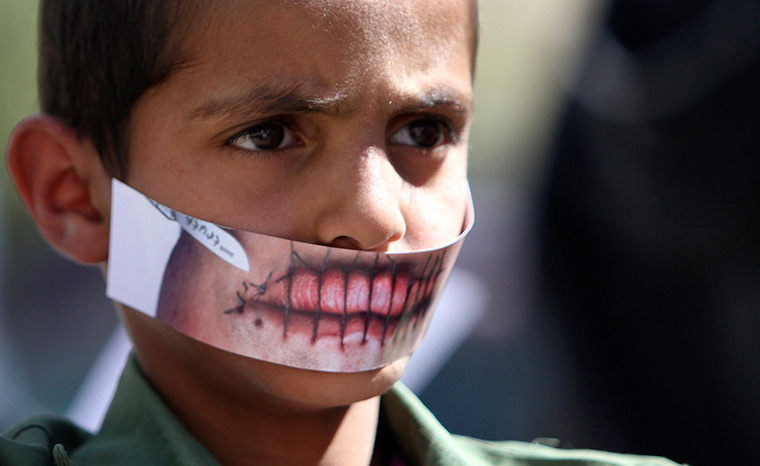Often political art is unimaginative, predictable, and didactic, but sometimes it can be horrific.
The boy is wearing a mask outside the UN office in Sana’a, Yemen. He is there as part of a protest “against the silence of the international community over the plight of Muslims in regions of conflict.” The caption sounds like it was written by a party communications officer, and I doubt that it was the boy’s idea to march down to the UN office. Nor is that mask something that was made in the schoolyard.
I wish it had never been made at all. Awful, terrifying, gruesome, grotesque: one shudders with each attempt to describe its effect. The lips sewn shut are profoundly disturbing, and all the more so for being placed over the child’s mouth. The ghastly distortion of the torture is magnified further by its now disproportionate size against his small, delicate features.
One assumes that the boy’s mouth has not been damaged, but one can’t shake the sense that he has been harmed by the mask. His lips are sealed so that he can’t speak, his mouth covered and nostrils almost covered, his body controlled by unseen adults ready to use him for their own political ends. There is something monstrous about the image he now presents to the world, and perhaps some demon lies behind it.
While protesting silence, he is there to be seen but not heard. More to the point, he is there to be photographed. And he was, and the image traveled well, and so the combination of two mute media–the mask and the photograph–creates a kind of speech. It is speech that can be easily understood: for example, I may have misread the situation regarding the specific protest, how it was organized, and how he got there. But it is precisely the ability to push everything else out of the picture that contributes to the rhetorical power of this close-cropped portrait. One art has relayed and amplified another, and by bringing the spectator into an almost intimate relationship with an unsettling depiction of suppressed speech, someone got the word out.
Still, I can’t help think that the child was used. Not to mention being made party to an act of symbolic violence that is perhaps overwrought, unnecessary, and even likely to habituate one to torture and other forms of actual violence. Perhaps this claim is itself overwrought and unnecessary, but it at least has the excuse of being provoked by artwork that was designed to be provocative. And really, what silence? The news sources I read are full of stories and images about Muslims suffering in regions of conflict. Today the stories included executions in Syria, riots in Egypt, civil wars in North Africa, more land grabs in the Occupied Territories, protests in Bahrain, and on and on. And, frankly, “Muslims” is a suspiciously broad category, is it not?
If there is silence, some of it may be self-imposed, and some of it might be inflicted on those who could have been allowed to think and speak for themselves, instead of being enlisted in yet another conflict.
Photograph by Mohamed Al-Sayaghi/Reuters.

Something I only just noticed about that mask: it’s on upside down. Look at the lips, the shape of the face, or for that matter the scalpel off to the left side with the word “truth” written on it, such that it appears to us upside down.
That realization, which I now can’t unsee, changes the implication of the image for me. I don’t think it makes the image comical, but that simple, dare I say childish mistake, goes a long way towards humanizing him as a figure. Can he really have been used by his elders if he was allowed to apply the mask himself? Wouldn’t they, in the interest of making sure that they had the intended impact, have made sure that it was right side up? Perhaps he isn’t such as unaware or unwilling participant as you believe.
Good observation. His elders could have still said, “Here, put this on,” and walked away sure of his obedience, but the complication remains.